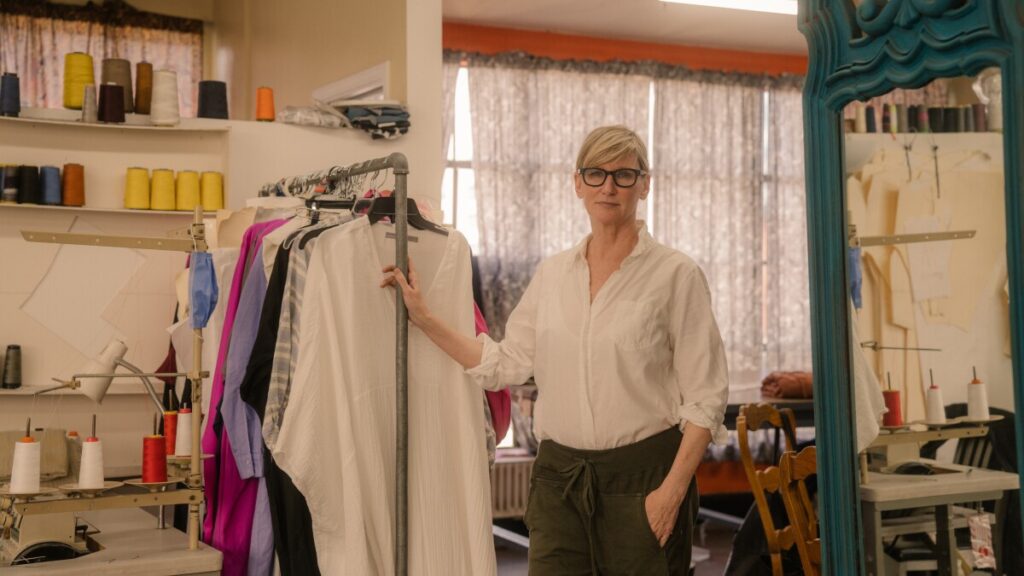Here’s something you might not have thought a lot about but, when it comes to environmental pollution, the fashion industry is a major culprit. Roughly, more than three-quarters of all the textiles worn in the U.S. from clothing and shoes end up in a landfill, according to data from the Environmental Protection Agency.
Fighting the appetite for fast fashion
It’s driven in part by a demand for inexpensive clothes that often reflect the trend of the moment but are not designed last past a season. Fast fashion brands like Zara, Forever 21 and Shein are extremely popular for this reason. But there’s been a movement to create more sustainable styles — clothes that last longer and are made locally with more organic materials. Some might call it “slow fashion,” and a lot of it is happening in Los Angeles.
“It’s really difficult to define sustainable fashion because there are so many factors,” says Tracie Tung, a professor of fashion design and merchandising at California State University Northridge. “It really needs a collective effort that’s beginning with designers, how they design their product, and how they can manage less waste.”
Made in LA
About 83% of all American-made clothing is made in L.A. and there’s a number of designers who have made the shift to producing clothes hyper-locally, and to recycle materials and make things that can be worn many times over for years — an important thing in our a climate-crisis stricken, fast-fashion world.
Mary Price is one of them. She started her small clothing brand Ocean + Main seven years ago. She had worked for a big fashion house but says she wanted to create a brand that truly represents the “ethos of Los Angeles.
“I’ve been in the business for 30 years and have seen the copious amounts of waste in production across the globe,” Price says. “And the way that we treat people and the planet to produce garments has gotten so far away from how we used to manufacture. Between making our clothes and growing our food, we’ve just gotten so far from the source.”
In her business, there’s no single use plastic. She ships products – caftans, dresses and gauzy pants – in cloth bags. She uses materials that are either upcycled or biodegradable. Every article of clothing is made within a few blocks downtown, and she says the company only produces what it can sell.
“There’s so much chaos created in the production of our clothes, from overproduction to overconsumption,” Price says. “In everything we do, we want to look at that decision. Is this creating calm or is it creating more chaos for people on the planet? So if it’s creating calm, we feel like it’s the right decision and we move forward with it.”
The How to LA team went downtown to check out Ocean + Main’s operation in L.A.’s Fashion District. In a recent episode, Price shares the intricate process of how she makes sustainable fashion work with host Brian De Los Santos and producer Megan Botel — from making textiles to the cutting of fabric to the packaging.
Mary Price, founder of clothing company Ocean + Main in L.A., talks to the How To LA team Brian De Los Santos and Megan Botel about how she tries to make her clothes as sustainably as possible with little waste.
(Aaricka Washington
/
LAist )
Fair labor practices
Probably the most important thing that separates a sustainable clothier from others, says CSUN’s Tung, is the treatment of the people who cut and sew the clothes. The U.S. Labor Department surveyed more than four dozen manufacturers and contractors last year and found that 80 percent of them violated wage laws — a practice that been going on for years. Often this has to do with manufacturers paying by piece, rather than by the hour. Last year’s survey found one manufacturer was paying its garment workers as little as $1.58 per hour
“If you can buy this item at a really cheap price, you can imagine how low the cost is, including how much money they pay to…laborers,” Tung says. “So for sustainable fashion, we of course are trying to find a balance between the cost and the affordability, but more focus will be on do we pay our workers fairly? Do we provide a comfortable and safe environment for our workers?”
Ocean + Main’s Mary Price tells How to LA that both part-time and full-time garment workers in her shop make “above the individual living wage benchmark of $21.22” per hour.
A garment worker named Daniel helps make the clothes at Ocean + Main, an L.A. based clothing company
(Aaricka Washington
/
LAist )
The downside to all this is, of course, the cost to the consumer. Clothes made sustainably are more expensive.
Tung’s response? “Change your shopping habits,” she says. “Create your own style, use your creativity, reduce consumption.”
Basically, buy less. Buy better.
Listen to the rest of the episode here.
Moving The Needle On Sustainable Fashion in LA
What questions do you have about Southern California?

